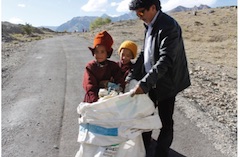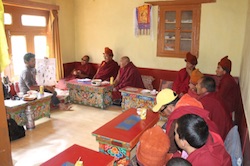| |
|
 |
Buddhist monks in Zanskar and Ladakh resolve to teach about snow leopard protection
January 25, 2016:
After a series of workshops in remote Zanskar, northern India, supported by ARC, monks and nuns have committed for the first time to preach the message of snow leopard protection. What follows is a short version of the 2015 report.
SummaryThere are about 5,000 to 6,000 snow leopards in the wild. One of the highest concentrations is in the Indian Buddhist region of Ladakh and Zangskar. In 2014 the Snow Leopard Conservancy conducted pilot workshops to work with Buddhist monasteries on protecting local wildlife and in 2015 with money from the Government of Norway through the Alliance of Religions and Conservation with support from WWF UK funding it expanded the programme to hold workshops in three monasteries and a nunnery in the remote area of Zangskar.
The feedback has been extraordinary: this was the first outside workshop of any kind at any of the monasteries, and this was their first environment teaching. Before this workshop they were unfamiliar with the importance of a healthy ecosystem and had little knowledge about the animals in their area.
They did not know how harmful packaged foods and drinks are, and almost all did not know to segregate waste for proper disposal. Many monks and nuns were excited and plan to incorporate what they had learned into their preaching in the future, and asked for further opportunities to engage with such workshops.
Background: Snowleopard workshops in Ladakh and Zanskar
 |
 |
 |
Picking up litter with novice monks at Stongdey |
People in Ladakh know little about the region’s wildlife, their population densities, distributions and conservation status. Therefore, an urgent need was felt by the Snow Leopard Conservancy India Trust (SLC-IT) for a comprehensive conservation awareness campaign. Thus, the organization started the Snow Leopard Conservation Education Program (SLCEP). Under this program, SLC-IT in collaboration with Kalpavriksh developed the Ri Gyancha, a biodiversity resource kit for Ladakh. To disseminate the information in this kit, SLC-IT conducts workshops for various stakeholders such as school children, village youth, school teachers and adults. In 2014, SLC-IT also started conducting workshops for monastics, an important stakeholder in nature conservation. Continuing this, we conducted workshops in Stongdey, Karsha and Zongkhul monasteries, and in Zangla nunnery in September 2015.
During the workshops, we apprised the monks and nuns of the status and distribution of various wild animals found in Zangskar. Since human-wildlife conflict is common, and humans often persecute wild animals in the region, we urged the monks and nuns to preach villagers against harming wild animals. Zangskar is cut off from the rest of Ladakh for almost 6 months in a year, and hence very little influence of modernization, we saw a great opportunity to involve the monks and nuns in creating conservation awareness among the local communities. The monks and nuns were very receptive to the ideas propounded, and they readily agreed to preach villagers against harming wild animals.
Furthermore, we made the monks and nuns aware about packaged food and waste management issues in Ladakh. The monks were apprised of the various health consequences of consuming processed food and packaged food, which not only make people obese and sick, but also pollute the environment. The monks were further informed about various diseases such as cancer that are afflicting the Ladakhi population as result of exposure to lead, mercury, bis-phenol A, dioxin, etc. The monks appreciated our efforts and requested us to conduct more of such workshops.
Rationale of the program Buddhism is based on acceptance and compassion, and it emphasises the high ecological value of all forms of life. It also recognises that all things are interdependent. Tibetan Buddhists believe that every animal has been your mother in a previous life, and taking the life of an animal is thus equated with taking the life of your own mother. Thus, Buddhist doctrines are very much compatible with environmental conservation. These however need to be highlighted and preached to local communities, so that they can practice them in their daily lives.
The Ladakh region in the northern Indian state of Jammu and Kashmir has a unique landscape and fragile environment preserved through age-old environmental practices. Majority of the population in Ladakh follows Buddhism, as mentioned earlier. In Zangskar region, almost 95% of the populations are Buddhists, and there is a great opportunity for leveraging this for furthering wildlife and environmental conservation in Ladakh. However, the monastics need to be educated about the status and distribution of wild animals in the region.
Zangskar has several unique and endangered wild animals including the snow leopard, which is one of the most charismatic and rare cats in the world. Most people do not understand the important role that the snow leopard plays in keeping the ecology in balance. Therefore, SLC-IT has recognized the importance of educating monastics in ecology, and then let them create conservation awareness among the people of Zangskar. This is especially so when the monks and nuns are held in high esteem in the Zangskari society.
 |
 |
 |
Discussing wildlife in Stongdey monastery in Zanskar |
The monastics also visit all households to perform religious rituals and ceremonies. Thus, they can teach people against harming snow leopards and other wildlife when they visit them in their homes. But for this, first they need to be educated and trained about wildlife conservation and other environmental issues.
Major outcomes During the workshops, almost all the monks and nuns pledged to preach villagers not to harm wild animals. These workshops were very enriching for us also, as we did not only teach the monks and nuns about the wildlife of Zangskar and the threats faced by them, but we also learned a lot from them regarding the relationship between Buddhism and Ecology.
The monastics requested us to organize more such workshops in future, which in a way reflects the importance of the program. Since the monks promised us that they will spread conservation messages among the villagers, and will preach them against harming snow leopard and other wildlife, we can be rest assured that the villagers will become more conversant with the conservation issues besetting the snow leopard and other wild animals and take measures that will improve the habitat conditions of the wild animals. These will also help in reviving the socio-religious protection of the snow leopard and their prey species.
The SLC-IT team and the monks cleaned the monastery precincts during the workshop. Although the Dalai Lama Foundation had provided garbage bins for sorting the garbage for proper disposal, the bins were not in use. After the workshop, we set the bins in place and urged monks to carry out frequent cleaning drives. The monks also talked on human-snow leopard conflict. They said that compensation should be given to the affected families. This will help mitigate their anger and revengeful attitude toward the snow leopard, which at times kill 30-40 sheep or goats in a single night.
Feedback from the monks and nunsMonks from all the three monasteries, and nuns from Zangla thanked SLC-IT and ARC for conducting such enlightening workshops. They said this is the first workshop they have ever attended at their respective monasteries and nunnery. Moreover, it is also the first workshop on religion and conservation they ever attended. Before this workshop they were not familiar with the importance of a healthy ecosystem and the crucial role-played by every living and non-living things in maintaining a healthy and balanced ecosystem.
Furthermore, they had very little knowledge about the types of mammals and birds found in Zangskar as well as in Ladakh. They also did not know as to how harmful packaged foods and drinks really are to humans, let alone having knowledge about proper disposal of products with toxic chemicals such as batteries and CFL bulb. Almost all the monks and nuns said that they never segregated waste for proper disposal. Based on topics covered during the workshop, the monks and nuns felt the need to conduct more such workshops. They also said that they would advocate environment and wildlife conservation, which is apropos to Buddhist teaching.
Stories/anecdotes shared by monks and nuns The monks at Stongdey monastery said that blue sheep visits the backyard of the monastery quite regularly, especially in winter, when the high slopes are covered with snow. It was proven the same day, when a monk came running to us telling about the animals in the back yard. He took us there to see them for ourselves. There were five blue sheep, three females and two lambs. They mentioned that they feed the blue sheep in winter. A monk asked if it is right to feed them, and our answer was negative.
Several monks at Stongdey and Karsha monasteries informed that they saw red foxes and magpies dead at carcasses of animals that were apparently poisoned to kill snow leopards and wolves. Some monks also reported the disappearance of magpies from Shadey village due to such acts. The monks also reported seeing rare animals like Eurasian lynx in and around Stongdey monastery. One monk also mentioned seeing a black-necked crane near Rangdum monastery.
 |
| "The same day a monk came running to us telling about the animals in the back yard. He took us there to see them for ourselves. There were five blue sheep, three females and two lambs. " |
|
 |
 |
The monks also apprised of the problem of stray dogs in Zangskar. They mentioned that the population of stray dogs has increased drastically. People often see them chasing juveniles of blue sheep and other ungulates that are the main prey species of the snow leopard. This in a way compels the snow leopard to kill domesticated livestock, often at the risk of losing its own life.
At Zongkhul monastery, Himalayan brown bear is a regular visitor. The monks there told us that a bear entered into the cell of a monk a week before our visit. There were also incidents of the bear entering the monastery’s kitchen, and causing great damage. Therefore, they requested SLC-IT to provide them with a deterrent light.
In Zangla nunnery, the nuns narrated a story of a snow leopard trapped inside a livestock corral. The snow leopard killed 25 goats and sheep in two nights (14 in the first and 11 in the second). However, on the second day, the villagers managed to trap it in the corral. They were all-furious and wanted to kill the snow leopard. Luckily K.C.Namgyal, Field Coordinator of SLC-IT Zangskar arrived at the site and rescued the poor cat.
|
 |
 |
|
|
|
|
|
 |
MONGOLIA: Buddhists and Environment Handbook
ARC, Gandan Monastery and the World Bank have combined to produce the first comprehensive guide to approaching and working with Buddhist
communities in Mongolia
|
 |
December 21, 2015:
Wonderful new Green Hindu Temple Guide
The Bhumi Project and ARC have created a Green Hindu Temples Guide: a beautifully-designed resource on how to make your temple or ashram greener and better and more Hindu in its relationship with the world around it. |
 |
Wildlife and Forests
Every faith teaches us about our relationship with the natural, wild world. This is why wildlife programmes are a particularly important area for ARC. |
 |
 |
|
|

